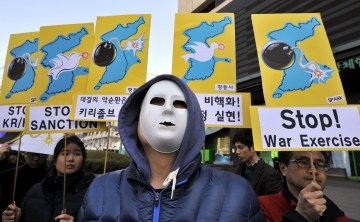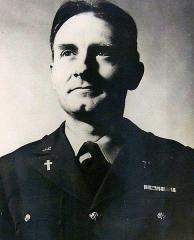A North Korean teacher holds open a children's pop-up book, which depicts a U.S. soldier killing a Korean woman with a hatchet, in a library room at Kaeson Kindergarten in central Pyongyang, March 9, 2013.
From the Pentagon to Panmunjom, U.S. defense officials conceded on Monday they are perplexed, and pondering, what Pyongyang will do next. American and South Korean defense officials are used to strange words and deeds from North Korea, but over the past week the Hermit Kingdom’s actions have reached unprecedented levels.
On Monday, North Korea carried through with its threat to declare the 1953 armistice ending the Korean War null, just as the South Korean and U.S. forces began an annual military exercise. “The U.S. has reduced the armistice agreement,” North Korea’s state-run media reported, “to a dead paper.” (See more North Korean war rhetoric.)
As a diplomatic exclamation point, the North cut off a Red Cross hotline linking the two Koreas. U.S. officials suggest the North Korean delegation at the truce village of Panmunjom may soon withdraw.
(MORE: North Korea Under Kim Jong Un: Old Threats, New Worries)
Last Thursday, the North Korean foreign military declared, through the Korean Central News Agency, that “the Supreme Command of the Korean People’s Army declared that it would totally nullify the Korean Armistice Agreement from March 11 when the U.S. nuclear-war rehearsal gets into full swing.”
On Friday, South Korea’s Yonhap news agency said:
[North Korean] Colonel General Kang Pyo-yong said soldiers are already positioned to launch a war of reunification if the order is given by its leaders. The paper said the general made clear at a speech given at a rally in Pyongyang that intercontinental ballistic missiles and other rockets capable of attacking preset targets have been armed with various types of atomic warheads.
Some of the fireworks are due to the recent rise to power of Kim Jong Un, whose father and grandfather ran North Korea before him as a military dictatorship. The new leader, either 29 or 30 years old and in office for a year, has to prove himself worthy with the hard-line North Korean military. Korea experts in the U.S. believe that accounts for some, if not all, of his nation’s recent bellicosity, which has been broadcast across North Korea.
Warns John McCreary, a longtime Defense Intelligence Agency analyst who now publishes the private NightWatch blog:
The intensive indoctrination of the North Korean public is more worrisome than specific announcements or actions. Through public statements, speeches and official news reports about actions at Panmunjom, North Korean leaders are generating a national perception that North Korea is under threat and that war is coming.

Antiwar activists hold placards showing the Korean Peninsula during a protest against a joint military exercise between South Korea and the U.S. in Seoul on March 11, 2013
Key Resolve 2013, slated to last 10 days, involves 3,000 U.S. and 10,000 South Korean troops in a regular exercise designed to protect South Korea from an invasion from the North — the same way the Korean War began on June 25, 1950. Army General James Thurman, the top U.S. commander in South Korea, called the war game “a critical exercise in strengthening the readiness of combined Republic of Korea and U.S. forces.”
Thurman and the U.S. government played down North Korea’s declaration that the armistice, signed on July 27, 1953, was no longer in force. “It concerns me when any signatory to a mutual agreement makes a public statement contrary to that agreement,” he said. “The success of the armistice has enabled the Republic of Korea to become a vibrant democracy, and we remain ready to defend the Republic of Korea.”
The U.S. government also imposed new sanctions on the North Korean Foreign Trade Bank on Monday, saying it helps fund the North’s missile and nuclear ambitions. Following the imposition of a new round of U.N. sanctions in the wake of a third nuclear-weapons test by the North last month, Pyongyang suggested it could attack Seoul and Washington with nuclear weapons, although U.S. officials think there is little to no chance on its threat to reach the U.S. capital.
(MORE: Inside North Korea: 10 Revealing New Satellite Snapshots from Google Maps)
“The United States will not accept North Korea as a nuclear state, nor will we stand by while it seeks to develop a nuclear-armed missile that can target the United States,” Tom Donilon, President Obama’s National Security Adviser, told the Asia Society in New York on Monday. “The international community has made clear that there will be consequences to North Korea’s flagrant violation of its international obligations, as the Security Council did again unanimously just last week in approving new sanctions in response to the North’s provocative nuclear test.”
There was a bittersweet symmetry to Monday’s stepped-up tensions on the Korean Peninsula: the North Koreans declared the armistice null shortly before the White House announced that Obama would award the Medal of Honor to U.S. Army Captain Emil Kapaun, a military chaplain who served in the Korean War. Kapaun was assigned to the 1st Cavalry Division’s 3rd Battalion, 8th Cavalry Regiment, during combat operations in early November 1950. When Chinese communist forces attacked U.S. positions, Kapaun calmly walked through enemy fire to provide comfort to his comrades. U.S. commanders ordered their able-bodied troops to withdraw, but Kapaun elected to stay with the wounded and make rounds amid hand-to-hand combat. He approached a wounded Chinese officer and got him to agree to the safe surrender of U.S. troops. Kapaun, a Roman Catholic priest, died in a North Korean prison camp on May 23, 1951.
Despite the current histrionics, the border between the two Koreas along the 38th parallel — the so-called demilitarized zone — has remained calm. Nonetheless, U.S. military officials expressed concern that the North might seize upon the U.S.–South Korean military drills — and the stepped-up sanctions — as a pretext for action.
“Expect a North Korean provocation in the coming weeks,” Korea experts Victor Cha and Ellen Kim say in an intelligence assessment, issued by the independent Center for Strategic and International Studies (CSIS). “Our research at CSIS shows that the North does a military provocation of some form within weeks of every South Korean presidential inauguration dating back to 1992 [South Korean President Park Geun-hye was inaugurated into office on Feb. 25]. Not a good prospect at all.”
But U.S. military officials are betting that any North Korea–launched strike would be small, to avoid triggering a massive counteroffensive that could lead to a war that would likely mark the end of the North Korean government.
In 2010, a North Korean artillery barrage killed four South Koreans, and a suspected North Korean torpedo sank the 1,200-ton South Korean corvette ROKS Cheonan, killing 46 sailors. The North purportedly launched both military strikes and didn’t pay a heavy price for doing so. Its leaders may be betting that they can do it yet again.
But one thing has changed. Despite diplomatic happy talk from General Thurman, the North has renounced the armistice. Legal niceties aside, that means — if South Korea and its U.S. ally are provoked for a third time — they may be less reluctant to fire back.
VIDEO: New North Korea Internet Video Shows Obama, U.S. Troops Up in Flames



